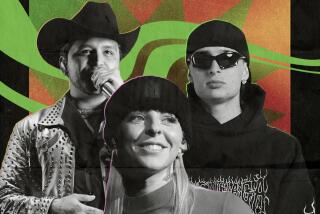Giving body and soul to the beat
For Grupo Corpo Brazilian Dance Theatre, bodies are the bearers of rhythmic good tidings. They flounce and pulse, swivel and lean, sail and rebound -- all while looking classically well-modulated and hopscotch-liberated. There is occasional jerking and flopping as well -- a bit of conflict and despair, that is, playing out to ominous clanking and bell tolling in episodic music landscapes.
But it’s nothing that a little samba can’t cure. Yet there was little danger of a one-note message during two works presented Friday night at Cal State Long Beach’s Carpenter Performing Arts Center. Instead, themes and variations evolved along constantly swerving pathways, showcasing a forest of gleefully precise dancers.
Both “21” (1992) and “Santagustin” (2002) were choreographed by Rodrigo Pederneiras, co-founder of the company in 1975 with his brother Paulo, who serves as artistic director. Their 20 dancers get less specific billing, listed only in a group, although a few had solos and duets of distinction. But the works do depend heavily on ensemble effort; they are a string of sections in which dancers resembled a quirky corps de ballet (working almost always in profile or facing forward), as well as denizens of the ballroom dance floor who have fractured all the rules except the ones about letting the backbone slip and keeping the beat.
Paulo Pederneiras’ constantly shifting lighting also seemed to dance at times, illuminating the flesh of shoulders and upturned faces from above, suddenly washing the stage in a rosy glow, or shrinking to a glaring spotlight that followed dancers across the shadowy stage.
In “21,” a bluish spell was cast in one segment, made misty behind a gauzy scrim. Dressed in pale unitards, dancers looked almost naked, spaced evenly apart, as they repeated a stylized walking in profile. Almost meditatively, they took a few steps and paused for a moment until a sudden pulse from the pelvis shivered them into motion again.
A woman in aqua walked against the crowd (the piece occasionally suggested individual breakaways) and, at the end, everyone’s pattern reversed quickly, emphasizing the scene’s dreamlike atmosphere.
Later, dancers wore candy-colored costumes in brighter light, as their configurations and rhythms kept changing, always elaborating musical impulses in a score by Marco Antonio Guimaraes. Repeated twangs sent forearms into circling patterns; syncopated flutes inspired a footwork tattoo or jutting hips and hands that were flung as if to shake off water.
The choreographer’s talent seemed most profound in partnering moments, when the illusion of flight was heightened by soaring melodies and physical maneuvers. In one duet, a man pulled a woman toward him and seemed to step back as she flew at him. Instead of being stilled by a grip as she was caught, she shaped herself over his shoulder, pulling him further into her trajectory. It happened so quickly, even a repetition of the movement couldn’t quite reveal how the feeling of flight became so intense.
“Santagustin” also had this sort of propulsive energy, as well as the satisfying match of percolating music and skittering activity. In a male duet, the momentum of a supported leap was kept going by swirling in a circle, the dancers somehow exchanging hand-holds and weight until the lifted moment reappeared and continued the orbit. A more defined theme emerged in this piece, with the dancers often falling into duets of flexible coupling and wearing apple-green body suits that had red patches highlighting erotic zones. A giant, fuzzy pink heart appeared in a projection behind them, and they indulged in a bit of refined wrestling, stylized thrusting and conjoined walks that resembled amorous praying mantises.
The score, by Tom Ze and Gilberto Assis, assisted with throbbing percussion, occasional panting and high-pitched singing that seemed to mimic hormonal surges.
Despite the occasional sense that this was a sitcom about amorous, hyperactive aliens going to the prom, “Santagustin” rose above whimsical surface delights. It’s possible that the ground always seems seriously solid when such elegantly rhythmic, inventively designed dance is built on it.
More to Read
The biggest entertainment stories
Get our big stories about Hollywood, film, television, music, arts, culture and more right in your inbox as soon as they publish.
You may occasionally receive promotional content from the Los Angeles Times.










